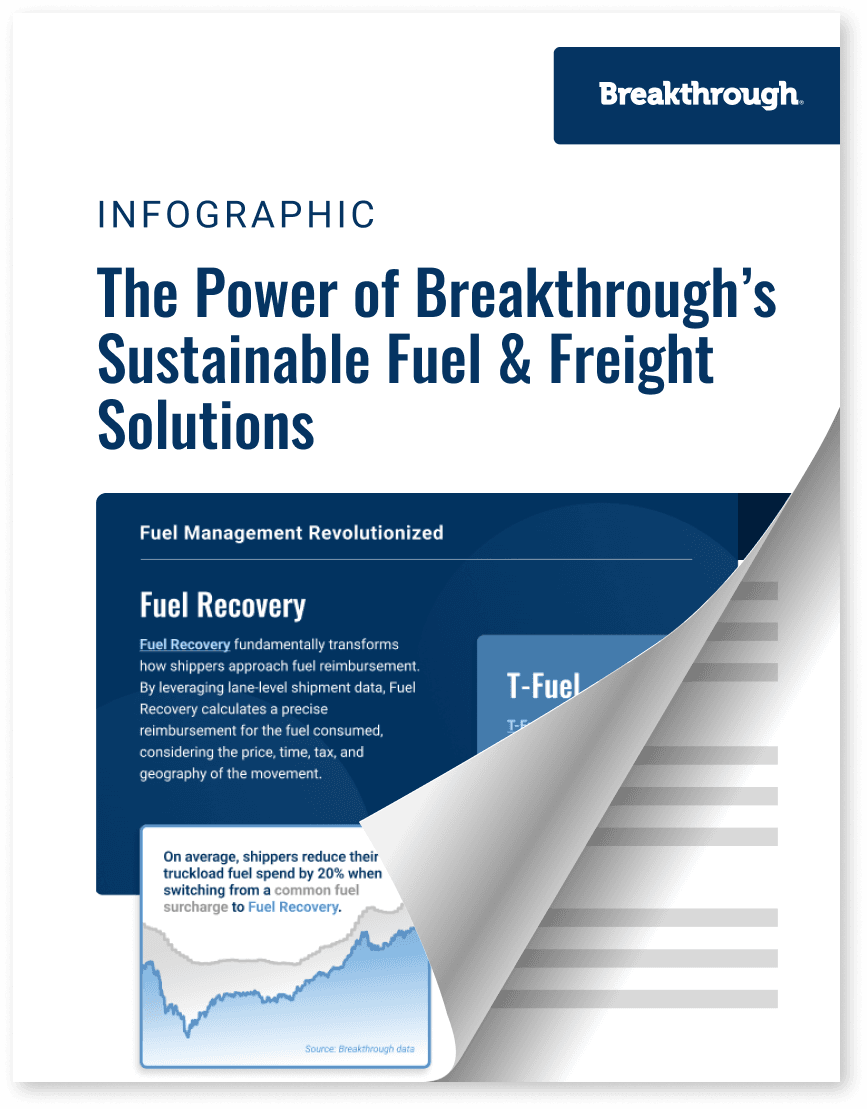The Power of Breakthrough's Sustainable Fuel and Freight Solutions

Freight
3 min read
July 17, 2024
Market Events
4 min read
July 16, 2024
Market Events
3 min read
July 8, 2024

8 min read
December 21, 2018

Share:
As shippers and carriers alike prepare their 2019 transportation and supply chain strategy, industry professionals often look toward budgeting inputs, supply/demand dynamics, and price forecasting. While these factors are integral in creating a comprehensive plan, one qualitative factor often overlooked can be the key to staying at the forefront of a rapidly changing industry—or even leading the charge. That factor is the startup landscape.
Since the solidification of startups in the marketplace around the time of the dot-com bubble, startups seek to address major industry problems, scale quickly, and disrupt traditional ways of thinking. For this reason, the rate of change must happen fast, so startup companies are forced to look beyond problems facing the market today. Consider any technology that was once revolutionary—on-demand video streaming or smartphones for example—that today is in nearly every household in the United States. Yesterday’s startup is now today’s commonplace solution, so shifting the gaze of this industry outward toward the future is a strategic way to stay ahead of the curve and achieve long-term success.
This pattern often makes startups a telling indication of where the future technology in an industry is moving—and the transportation and supply chain industry is no exception.
The stark upward trend in transportation and supply chain start-up investment is evident in a study conducted by Freight.Tech – FreightWaves’ engagement platform that connects early-stage startups with investors and corporate enterprises. The study reveals 162 startups from the 2018 Inc. 5000 emerging from the logistics and transportation sector, with three new ventures falling in the top 10 in terms of financial growth.

2018 emerged as an explosive year for logistics and transportation expansion, gaining exponential traction due to the industry’s strong potential for disruption and continued adherence to innovation. Technology continues to catalyze new start-ups, providing the transformative power that distinguishes potential disruptors in a congested transportation space. The charts above show the range of investment in the selected transportation and logistics startups (of the 162 total), revealing substantial investment through Q3 2018. The different stages of investment that transpired are also shown, based on investor confidence in each venture and/or the experienced growth that each start-up has achieved since their initial launch.
As we enter 2019, several key transportation and supply chain startup trends of note enter the spotlight:

What are these technologies, and why have they become increasingly relevant in the modern supply chain industry? The answer overarchingly points towards the desire for digitization. While these three trends are among many seen in the industry (logistics management devices, electric vehicles, autonomy, and artificial intelligence) they stand to be at the heart of innovation in 2019, either enabling, or being enabled by, other disruptive technologies.
As both supply chains and transportation networks strive for increased agility in ever-changing and volatile markets, shippers and carriers alike are seeking real-time, on-demand tracking features. Many companies boast their “tracking” technology, but it is important to note that this may manifest in a variety of deliverables based on their definition of the word.
Tracking platforms may be implemented via on-board telematics devices like electronic logging devices (ELDs), or through independent software installed in the cab of a truck. They could tap into GPS data, or simply offer “track and trace” services via touch points along the supply chain, like at distribution centers and final-mile delivery.
Freight visibility and tracking has been in production and use for years – this concept is not new, but companies are now working to make the delivery of this information more digital and engaging. While gaining real-time visibility into freight movements is attractive for many shippers and carriers, under the surface it remains ineffective in actually driving change in your transportation network. It is important to understand that freight visibility only results in actionable insights when effective strategy is established on the front end. To utilize this data to its fullest potential, shippers need to develop a plan to leverage it to create deeper insights and analysis prior to implementation of the technology.
Knowing the location of your freight is one thing, but selecting the right partners on the front-end, and driving continued optimization of transportation operations through ongoing compliance management is the only way to ensure that your goods are moving in the most efficient and successful way possible.
As technology and data become more complete and accessible, the attractiveness for on-demand trucking features grows. Especially in environments with tight capacity, as has been the case for most of 2018, spot markets become tedious, challenging, and expensive to secure carriers to move freight.
Some startups aim to mitigate those challenges with “easy-load booking” and “book with one click” approaches. Rather than sending freight to the spot market to re-engage with carriers in a negotiation, startups in this space are working to digitize the process, eliminating human interaction that often leads to delays. The convenience factor of finding a truck instantaneously with a set rate becomes compelling.
Much like “real-time tracking,” however, this idea may simply be a “band-aid” for a larger problem, which points to holes in the front-end strategy of primary carrier selection. Rather than innovating to find a reactionary solution for non-compliance or network disruptions, utilizing historic data and lane-level analysis of freight flows empowers shippers to create the most optimal strategy from the outset, diminishing the need for on-demand trucking solutions and brokerages in general.
For information about Breakthrough’s supply chain solution - FELIX - that leverages a robust shipper and carrier dataset with your unique, lane-level transportation network to create actionable strategy and ongoing optimization, contact us.
Due to concerns about tight capacity and the driver shortage seen in 2018, trucking companies are looking for ways to make truck driving safer and more efficient. When the attraction and retention of drivers is a pain point, the efforts of the drivers that are in operation need to be maximized—which includes the introduction of risk management technology.
On-board video technology and driver monitoring help increase driver performance and experience while driving—eliminating some of the manual instinct and skill necessary to achieve higher fuel efficiencies that often decrease due to heavy braking and fast acceleration. This technology can also predict inclement weather, traffic, or construction slowdowns giving the driver visibility into the most efficient lane possible—often being automatically rerouted.
Video technology can serve as evidence to protect drivers in the event of an accident and gives line-of-sight to blind spots around the vehicle. All this data and information provides ample training material to make drivers more successful on the road.
Everything from augmented and virtual reality, to ELDs are working towards making the driver experience as data-driven and high-tech as possible to not only increase performance on the road, but to “gamify” the driver experience to attract and retain a robust driver workforce. Driver attraction and retention plays an important role in the overall freight picture, as truck orders hit record highs in 2018, giving drivers the potential opportunity to drive the newest trucks with the latest technology. More drivers filling the cabs of these newly acquired trucks, will likely contribute to loosening freight demand in the long-term, barring any major fluctuations in other key market drivers of freight supply and demand.
Read more about truck ordering trends in 2018 and how they may affect capacity challenges in transportation.
As we enter 2019, society is becoming ever-more data and technology-driven, therefore it is reasonable to expect efforts to catalyze similar change in the transportation industry to endure. Disruptive change occurs at an exponential rate, and we are on the cusp of the largest rate of change seen to date.

Understanding how the transportation and supply chain industries expect to evolve is a crucial step in positioning your organization’s strategy for success in the long-run. As data becomes more powerful and technology continues to leverage it to foster increased transparency, the efficiency opportunities in the freight space are unprecedented.
The trends of today will one day become the status quo of tomorrow, so it is important to both recognize where the transportation and supply chain industry is focused in 2019, but also to understand that these trends are fleeting and ever-changing. What will endure, however, is a commitment to a strategy firmly rooted in data, and unbound by traditional ways of doing business. The sky is the limit.
For information about Breakthrough’s solutions, or questions about the transportation and supply chain industry, contact us.

3 min read
July 17, 2024
Maximize transportation efficiency with cohesive fuel and freight strategies. Discover the power of enhanced visibility, cost-effectiveness, and sustainability.
Read more
4 min read
July 16, 2024
Discover how the recent elections in Mexico and the EU are expected to influence energy policies, fuel prices, and dynamics in the transportation sector.
Read more
3 min read
July 8, 2024
Understand the state-specific changes in diesel tax rates and explore strategic solutions for shippers to accurately calculate fuel reimbursements to carriers.
Read more